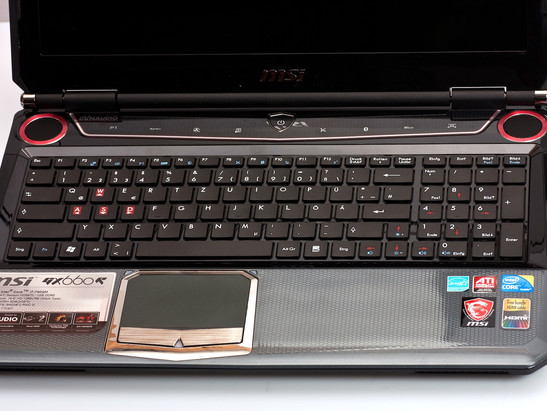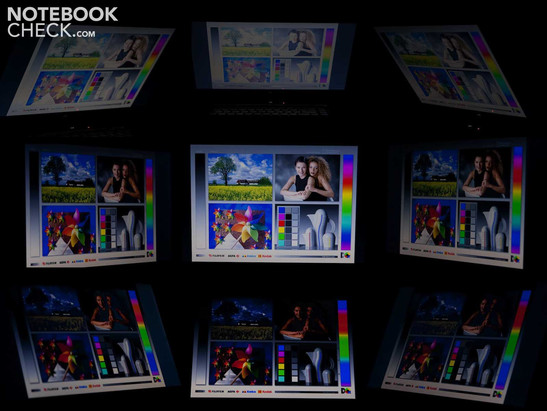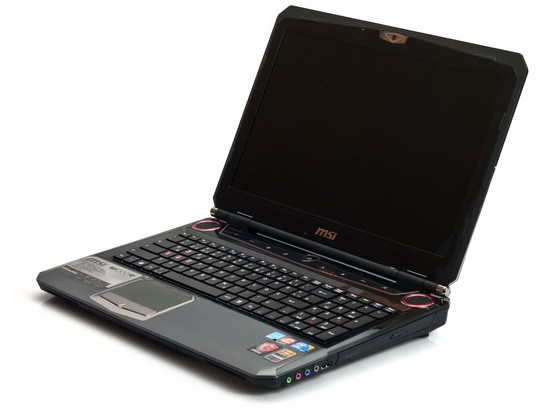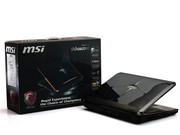Review Update: MSI GX660R Gaming Notebook

A little while ago we reviewed the pre-production model of the GX660R, the overall rating of 81% was quite good for a pre-release model. However, this review didn't accurately reflect to product later offered to consumers. For example, the pre-release model was equipped with an HD-ready (720p) display, while the current model was bumped up a notch and fitted with a full-HD (1080p) display.
Now that MSI has provided us with an up-to-date model of the GX660R available to consumers, we reevaluated some areas of the previous review. In doing so, we paid particular attention to the benchmarks and the display. If you'd like to first take a look at the original review of the pre-production model, you can find it here.
Input Devices
Keyboard
In terms of looks, nothing has changed about the keyboard, but it's evident that MSI has been working hard behind the scenes in the time between the release of the pre-production and consumer models. In the original review, we criticized the flimsy keys and how the keyboard easily caved in under pressure. Now, the keyboard acts the way a gaming notebook's keyboard should. Keystrokes are crisp and the keys react quickly and accurately. The rickety sound of keystrokes as well as the case bending to pressure while typing are a thing of the past. MSI has definitely made some improvements here.
Display
The greatest difference between the pre-production model and the final consumer model is the display. The screen remains glossy, measuring 15.6 inches diagonally with an aspect ratio of 16:9. This time, however, the picture is reproduced at a higher resolution. While the pre-release model had an HD-ready display, the updated consumer version goes all the way with a full-HD display (1080p).
Unfortunately though, the new display doesn't quite reach the brightness level of the old screen. Also, the distribution of brightness across the screen dropped down a bit to 80%. The contrast ratio, too, took a hit on account of the lower screen brightness, falling to 145:1.
| |||||||||||||||||||||||||
Brightness Distribution: 80 %
Center on Battery: 193 cd/m²
Contrast: 145:1 (Black: 1.33 cd/m²)
28.23% AdobeRGB 1998 (Argyll 3D)
39.29% sRGB (Argyll 3D)
28.69% Display P3 (Argyll 3D)
Performance
Not much has changed in terms of hardware between the pre-production model and the consumer model, only the RAM has been increased from 4 GB to 6 GB. Other than that, our new test model contains the same Intel Core i7-740QM processor, clock rated at 1.73 GHz, and an ATI Mobility Radeon HD 5870. You can find more details about the hardware in our original review.
In order to test the performance of the current consumer model, we ran our benchmarks on the new model. There were no big surprises here. Either both models performed at the same level or the new consumer version came out slightly ahead. This slight improvement is most likely to be attributed to new drivers and the additional 2 GB of RAM that the new model of the GX660R is fitted with.
| PCMark Vantage Result | 5915 points | |
Help | ||
In the CineBench test, the new consumer model leaves the pre-production model trailing by a bit. Although the 32-bit test results are nearly identical, the new model stands out a good deal in the 64-bit test, outdoing the pre-release model by several 100 points.
| 3DMark 03 Standard | 38290 points | |
| 3DMark 05 Standard | 18774 points | |
| 3DMark 06 Standard Score | 13253 points | |
| 3DMark Vantage P Result | 8548 points | |
Help | ||
In the 3D Mark benchmark, there are no noteworthy differences between the two versions of the notebook. Both models rank in just about the same.
Gaming Verdict
The games played on both versions of the GX660R also produce only negligible differences in performance. The new results were just about the same as the ones for the pre-production model. The ATI Mobility Radeon HD 5870 graphics card produces excellent gaming performance all the same in the new model, allowing current games run smoothly in the native resolution with high graphics settings on.
| low | med. | high | ultra | |
|---|---|---|---|---|
| Crysis - GPU Benchmark (2007) | 142 | 67 | 50 | |
| Crysis - CPU Benchmark (2007) | 114 | 72 | 56 | |
| Far Cry 2 (2008) | 118 | 83 | 33 | |
| F.E.A.R. 2 (2009) | 192 | 110 | 84 | 41 |
| StarCraft 2 (2010) | 166 | 63 | 58 |
Emissions
System Noise
The noise level between the two models has not changed much. In idle mode, the new consumer model is somewhat quieter than the pre-release model. Under heavy use, too, the noise level measured was slightly lower. Still, the notebook remains fairly loud.
Noise level
| Idle |
| 34.1 / 33.9 / 34.3 dB(A) |
| HDD |
| 34.6 dB(A) |
| DVD |
| 36 / dB(A) |
| Load |
| 39.6 / 47.6 dB(A) |
 | ||
30 dB silent 40 dB(A) audible 50 dB(A) loud |
||
min: | ||
Temperature
In terms of case temperature, the new consumer version is a bit cooler than the pre-production model. The temperature measured in the new model was slightly lower. In idle mode, the temperature dropped by 2 to 4ºC in different spots on the case. The temperature under heavy use also dropped a bit.
During the stress test, we were baffled when processing speed of the GX660R suddenly dropped. Considering that the pre-production model did nothing of the kind, we searched around for the cause of this drop in performance. We finally found the reason to be the power supply. At 90 watts, it wasn't capable of handling the notebook's power consumption capacity. We followed up with MSI and it turns out we actually received the wrong power supply. Instead of the intended 120-watt power supply, we received a 90-watt one. With the standard power supply, the throttled performance issue should not come up.
(+) The maximum temperature on the upper side is 32.7 °C / 91 F, compared to the average of 40.5 °C / 105 F, ranging from 21.2 to 68.8 °C for the class Gaming.
(+) The bottom heats up to a maximum of 39.6 °C / 103 F, compared to the average of 43.3 °C / 110 F
(+) In idle usage, the average temperature for the upper side is 22.3 °C / 72 F, compared to the device average of 33.9 °C / 93 F.
(+) The palmrests and touchpad are cooler than skin temperature with a maximum of 25.4 °C / 77.7 F and are therefore cool to the touch.
(+) The average temperature of the palmrest area of similar devices was 28.9 °C / 84 F (+3.5 °C / 6.3 F).
Between the original pre-production GX660R and the new model available to consumers, there are few differences. The only serious improvement is represented by the full-HD display, which truly enhances to overall quality of the GX660R. The keyboard, too, was clearly raised to the standards at which a gaming notebook's keyboard should perform. All other sections of the original review apply to the new GX660R model. All in all, several weak points of the notebook have been improved upon, allowing it to hold its ground a bit better against the competition.
The loud cooling system and short battery life remain. If the noise level doesn't bother you and you plan to mostly use the notebook plugged in, you'll find the MSI GX660R to be a powerful notebook at a fair price.

















